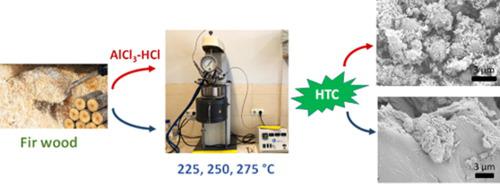Our official English website, www.x-mol.net, welcomes your
feedback! (Note: you will need to create a separate account there.)
Hydrothermal carbonization of lignocellulosic biomass and effects of combined Lewis and Brønsted acid catalysts
Fuel ( IF 6.7 ) Pub Date : 2020-11-01 , DOI: 10.1016/j.fuel.2020.118458 Tolgahan Evcil , Hamza Simsir , Suat Ucar , Kubilay Tekin , Selhan Karagoz
Fuel ( IF 6.7 ) Pub Date : 2020-11-01 , DOI: 10.1016/j.fuel.2020.118458 Tolgahan Evcil , Hamza Simsir , Suat Ucar , Kubilay Tekin , Selhan Karagoz

|
Abstract This study is the first to investigate the effect of combined Lewis and Bronsted acid catalysts on the hydrothermal carbonization of fir wood samples; here, hydrothermal carbonization of fir wood–with and without catalyst–was performed. In non-catalytic runs, the effects of temperature and residence time on hydrochar yields were investigated; temperature significantly affected hydrochar yields, whereas residence time had very little effect. A gradual increase in temperature resulted in a decrease in hydrochar yields while increasing the carbon content of hydrochars. At all tested temperatures, the use of a catalyst led to a decrease in hydrochar yields. The highest heating value of 29.12 MJ kg−1 was obtained at the highest temperature (275 °C) and the longest residence time (24 h). The use of catalysts slightly decreased the heating values. The hydrochars were mainly in the class of lignite coal; hydrochar obtained at 275 °C and a residence time of 12 h–either with or without catalysts–was classified as bituminous coal. Irregular carbon sphere formation was observed at all temperatures tested in the catalytic runs; however, no carbon spheres were observed in the non-catalytic runs. XRD patterns of hydrochars from the non-catalytic runs were similar for temperatures of 225, 250 and 275 °C; the peak observed at 2θ of 22° broadened after HTC processing. In the catalytic runs, two new peaks at 2θ of 38° and 49° were observed, in addition to broadened peaks (2θ = 22°). The use of catalysts led to the formation of the secondary char.
中文翻译:

木质纤维素生物质的水热碳化和路易斯酸和布朗斯台德酸催化剂的组合作用
摘要 本研究首次探讨了路易斯酸和布朗斯台德酸催化剂对冷杉木样品水热碳化的影响;在这里,进行了冷杉木的水热碳化——有和没有催化剂——。在非催化运行中,研究了温度和停留时间对水焦产率的影响;温度显着影响碳氢化合物的产率,而停留时间影响很小。温度的逐渐升高导致氢化炭产率降低,同时增加了氢化炭的碳含量。在所有测试温度下,催化剂的使用导致氢化炭产率下降。在最高温度 (275 °C) 和最长停留时间 (24 h) 下获得了 29.12 MJ kg-1 的最高热值。催化剂的使用略微降低了热值。烃类主要为褐煤类;在 275 °C 和 12 小时的停留时间(有或没有催化剂)下获得的 Hydrochar 被归类为烟煤。在催化运行中测试的所有温度下都观察到不规则的碳球形成;然而,在非催化运行中没有观察到碳球。对于 225、250 和 275 °C 的温度,来自非催化运行的加氢碳的 XRD 谱相似;在 HTC 处理后,在 22° 的 2θ 处观察到的峰变宽。在催化运行中,除了加宽的峰 (2θ = 22°) 外,还观察到了 2θ 38° 和 49° 处的两个新峰。催化剂的使用导致二次炭的形成。在 275 °C 和 12 小时的停留时间(有或没有催化剂)下获得的 Hydrochar 被归类为烟煤。在催化运行中测试的所有温度下都观察到不规则的碳球形成;然而,在非催化运行中没有观察到碳球。对于 225、250 和 275 °C 的温度,来自非催化运行的加氢碳的 XRD 谱相似;在 HTC 处理后,在 22° 的 2θ 处观察到的峰变宽。在催化运行中,除了加宽的峰 (2θ = 22°) 外,还观察到了 2θ 38° 和 49° 处的两个新峰。催化剂的使用导致二次炭的形成。在 275 °C 和 12 小时的停留时间(有或没有催化剂)下获得的 Hydrochar 被归类为烟煤。在催化运行中测试的所有温度下都观察到不规则的碳球形成;然而,在非催化运行中没有观察到碳球。对于 225、250 和 275 °C 的温度,来自非催化运行的加氢碳的 XRD 谱相似;在 HTC 处理后,在 22° 的 2θ 处观察到的峰变宽。在催化运行中,除了加宽的峰 (2θ = 22°) 外,还观察到了 2θ 38° 和 49° 处的两个新峰。催化剂的使用导致二次炭的形成。在非催化运行中没有观察到碳球。对于 225、250 和 275 °C 的温度,来自非催化运行的加氢碳的 XRD 谱相似;在 HTC 处理后,在 22° 的 2θ 处观察到的峰变宽。在催化运行中,除了加宽的峰 (2θ = 22°) 外,还观察到了 2θ 38° 和 49° 处的两个新峰。催化剂的使用导致二次炭的形成。在非催化运行中没有观察到碳球。对于 225、250 和 275 °C 的温度,来自非催化运行的加氢碳的 XRD 谱相似;在 HTC 处理后,在 22° 的 2θ 处观察到的峰变宽。在催化运行中,除了加宽的峰 (2θ = 22°) 外,还观察到了 2θ 38° 和 49° 处的两个新峰。催化剂的使用导致二次炭的形成。
更新日期:2020-11-01
中文翻译:

木质纤维素生物质的水热碳化和路易斯酸和布朗斯台德酸催化剂的组合作用
摘要 本研究首次探讨了路易斯酸和布朗斯台德酸催化剂对冷杉木样品水热碳化的影响;在这里,进行了冷杉木的水热碳化——有和没有催化剂——。在非催化运行中,研究了温度和停留时间对水焦产率的影响;温度显着影响碳氢化合物的产率,而停留时间影响很小。温度的逐渐升高导致氢化炭产率降低,同时增加了氢化炭的碳含量。在所有测试温度下,催化剂的使用导致氢化炭产率下降。在最高温度 (275 °C) 和最长停留时间 (24 h) 下获得了 29.12 MJ kg-1 的最高热值。催化剂的使用略微降低了热值。烃类主要为褐煤类;在 275 °C 和 12 小时的停留时间(有或没有催化剂)下获得的 Hydrochar 被归类为烟煤。在催化运行中测试的所有温度下都观察到不规则的碳球形成;然而,在非催化运行中没有观察到碳球。对于 225、250 和 275 °C 的温度,来自非催化运行的加氢碳的 XRD 谱相似;在 HTC 处理后,在 22° 的 2θ 处观察到的峰变宽。在催化运行中,除了加宽的峰 (2θ = 22°) 外,还观察到了 2θ 38° 和 49° 处的两个新峰。催化剂的使用导致二次炭的形成。在 275 °C 和 12 小时的停留时间(有或没有催化剂)下获得的 Hydrochar 被归类为烟煤。在催化运行中测试的所有温度下都观察到不规则的碳球形成;然而,在非催化运行中没有观察到碳球。对于 225、250 和 275 °C 的温度,来自非催化运行的加氢碳的 XRD 谱相似;在 HTC 处理后,在 22° 的 2θ 处观察到的峰变宽。在催化运行中,除了加宽的峰 (2θ = 22°) 外,还观察到了 2θ 38° 和 49° 处的两个新峰。催化剂的使用导致二次炭的形成。在 275 °C 和 12 小时的停留时间(有或没有催化剂)下获得的 Hydrochar 被归类为烟煤。在催化运行中测试的所有温度下都观察到不规则的碳球形成;然而,在非催化运行中没有观察到碳球。对于 225、250 和 275 °C 的温度,来自非催化运行的加氢碳的 XRD 谱相似;在 HTC 处理后,在 22° 的 2θ 处观察到的峰变宽。在催化运行中,除了加宽的峰 (2θ = 22°) 外,还观察到了 2θ 38° 和 49° 处的两个新峰。催化剂的使用导致二次炭的形成。在非催化运行中没有观察到碳球。对于 225、250 和 275 °C 的温度,来自非催化运行的加氢碳的 XRD 谱相似;在 HTC 处理后,在 22° 的 2θ 处观察到的峰变宽。在催化运行中,除了加宽的峰 (2θ = 22°) 外,还观察到了 2θ 38° 和 49° 处的两个新峰。催化剂的使用导致二次炭的形成。在非催化运行中没有观察到碳球。对于 225、250 和 275 °C 的温度,来自非催化运行的加氢碳的 XRD 谱相似;在 HTC 处理后,在 22° 的 2θ 处观察到的峰变宽。在催化运行中,除了加宽的峰 (2θ = 22°) 外,还观察到了 2θ 38° 和 49° 处的两个新峰。催化剂的使用导致二次炭的形成。











































 京公网安备 11010802027423号
京公网安备 11010802027423号